Photo

454 notes
·
View notes
Text
I have been stress finger crocheting
4 notes
·
View notes
Photo
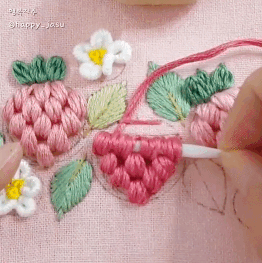

Happy_jasu on ig
8K notes
·
View notes
Photo

84 notes
·
View notes
Photo
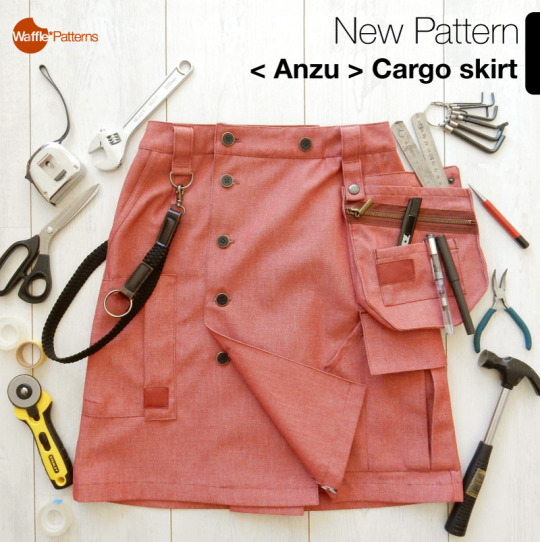

Meet new sewing pattern <Anzu> Cargo Skirt
Meet the new item from Waffle Patterns Cargo skirt <Anzu> sewing pattern. This is a work/outdoor-wear inspired A-line skirt with functional details and many pockets, like a tool pocket, hammer loop, or holster pocket.
Make it with all the fun options or just keep it simple for daily use as you like. Depending on the design options or fabrics, it will be a hiking skirt, work apron or travel skirt, etc.
This is also a skirt version of my popular pattern <Azuki> cargo pants. If you like work/outdoor items, please try Azuki pants, too.
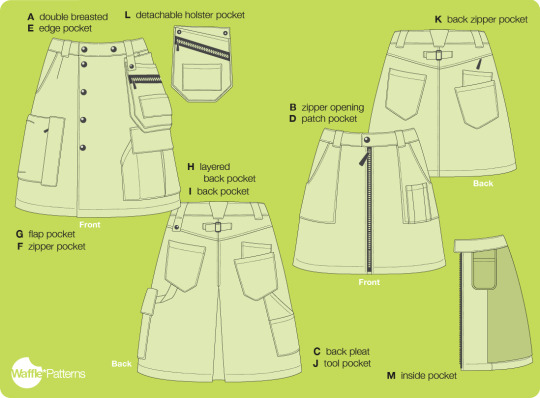
<Design options>
The front opening has 2 options; double-breasted with button closure or zipper opening. I think the zipper type is suitable for daily use and double breasted will be fun for a work apron. The side pockets are also 2 types. Please choose from the edge type and easy patch type.
For the long-length version, you can add three more patch pockets. They are all workwear-inspired functional designs; zipper pocket, flap pocket, and back tool pocket.
My favorite is the back zipper pocket on the yoke. I think it’s also nice to make with waterproof materials like thin nylon for hiking or travel skirts.
You can sew with or without the details like adjuster belt, hammer loop, inside pocket, back pleats, or lining. Please choose them as your fabric and design intention.
The yellow sample in the photos is intended for daily casual wear, featuring short length + side patch pockets + zipper opening.
The salmon pink sample is more like a workwear style. I made it with long length + back pleats + double-breasted front opening and add many fun pockets.

<fabric recommendation>
The pattern is drafted for woven fabrics. Medium weight skirt fabrics will be suitable. For the authentic workwear style, denim, canvas, duck, cotton twill or chino are suitable. For travel/hiking skirts, outdoor fabric like softshell, water-repellent or some quilted fabric will be an interesting option. Just make sure that some specially thick fabrics are not suitable for details like pockets or pleat. Also some fabrics may require size adjustment, I recommend to make muslin for perfect fit.
It includes the lining pattern, too. Of course you can sew without a liner. Please choose suitable lining material depending on the shell and your design intention.
The salmon pink sample was made with mid-weight cotton duck. It was very easy to handle and a very fitting material for workwear.
The yellow sample is a mixed cotton twill. It is quite thick, so I avoided unsuitable details like the back pleat, layered pocket, etc.
I’m planning to make one more for the winter season with quilted fabric or water repellent fabric with warm fleece lining.


<Other>
You can make it with or without the back pleat. For outdoor/work use, the pleat version will be more reasonable for more movement ease.
The detachable holster pocket shares the same size/design as Azuki cargo pants. If you already made the pants, you can use the same pattern if the size is the same.

*********************
The sewing pattern includes the 19 pages instruction and all the sewing processes are described with detailed illustrations. The pattern files are available for both home printers (A4 or US letter) and copy shop(A0 format).
You can check other photos of this model on my Flickr page.
The Cargo skirt -Anzu- (size 32-52) PDF sewing pattern is available here. Also in the Etsy shop.
Special discount price until 15th April(CEST) with other popular patterns. No discount code is needed! The sale page is here.
***** Special offer +12EUR for Paper pattern and free shipping
Paper pattern + PDF option is available with plus 12EUR. Shipping worldwide. But please note that, in the current situation, all the shipments are affected by the measure of COVID-19. There might be some shipping delays or accidents. *The paper includes only the pattern, please print out the instruction by yourself or read it with your tablet or PC. The PDF + Paper listing page is here.
*In the sale period, the shipping of the paper pattern starts 16th Apr.
Enjoy your sewing!
(Japanese post here 日本語ポストはこちら).
**********************
follow me! Instagram /// Twitter /// Facebook /// Shop /// Pinterest //// Etsy Shop /// Newsletter
1K notes
·
View notes
Video
Strawberry Shortcake & Lemon Meringue Cardigans by theycallmelash
73K notes
·
View notes
Note
any advice on making capes?
Ooh, I love capes!
Making capes
Types of capes:
There are different types of capes. Let's take a look at a few options.
Rectangle cape: the type of cape American superheroes wear. They consist out of a simple rectangle that can be tied or clasped at the neck. Use gathered fabric for extra fullness. This type of cape won't give you a lot of warmth as it will only cover your back.
Quarter circle cape: slightly more flared than a rectangle cape, but will still only cover your back.
Half circle cape: will cover both your back and shoulders and some of your body, which will give you extra warmth. Great for drama!
Fitted half circle cape: similar to a half circle cape, but made out of three separate pieces to fit around your body better. It won't cover you completely, but it will cover your back, shoulders, and more of your body than a normal half circle cape would.
Full circle cape: this cloak will cover your full body and keep you nice and warm.
Savvy sewists will notice these cape types are similar to circle skirts. The idea's basically the same. Instead of making a skirt, you leave your circle open in the front, and cut a hole that fits your neck rather than your waist.

(Image source) [ID: drawing showing five types of coats: rectangle, quarter circle, half circle, half fitted circle, full circle. Text: "Capes and cloaks. www.facebook.com/aliceincosplayland".]
Aside of volume, you can also play around with length. A floor-length cape has a very different effect and function than a cape that reaches your hips, or even a capelet.
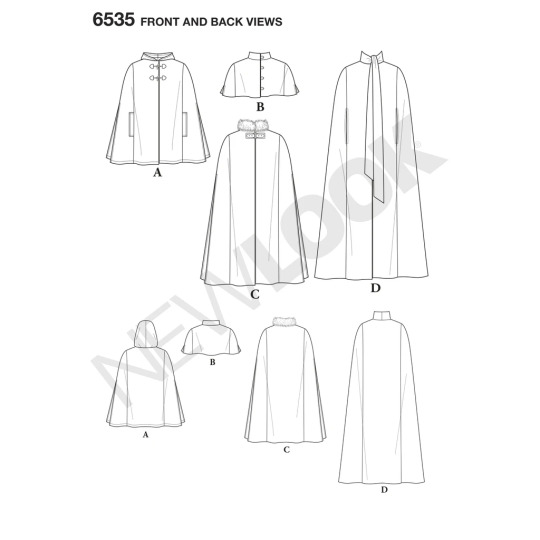
(Image source) [ID: a pattern diagram showing four different cape lengths: floor length, hip length, waist length, and a capelet. Text: "6535 Front and back views. Newlook."]
Details like a hood or armholes can make your cape extra comfortable, and you've got a wide range of options when it comes to fasteners, too.

(Image source) [ID: back view of a long gray half circle cape that's been pleated at the shoulders.]
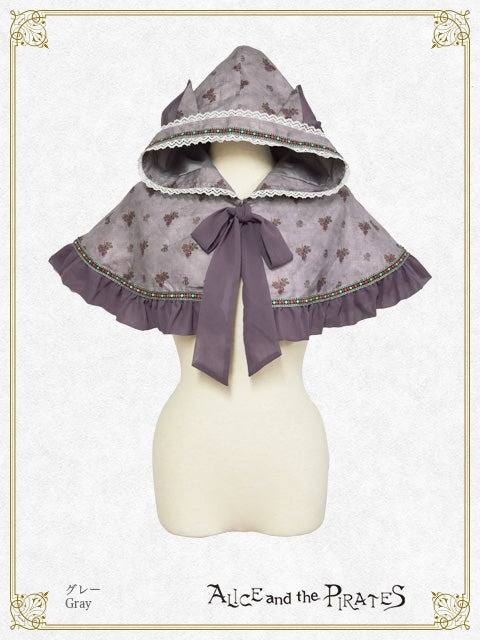
(Image source) [ID: a purple capelet with a hood, frills, cat ears, and lace, tied with a bow at the front. Text: "Gray. Alice and the Pirates."]
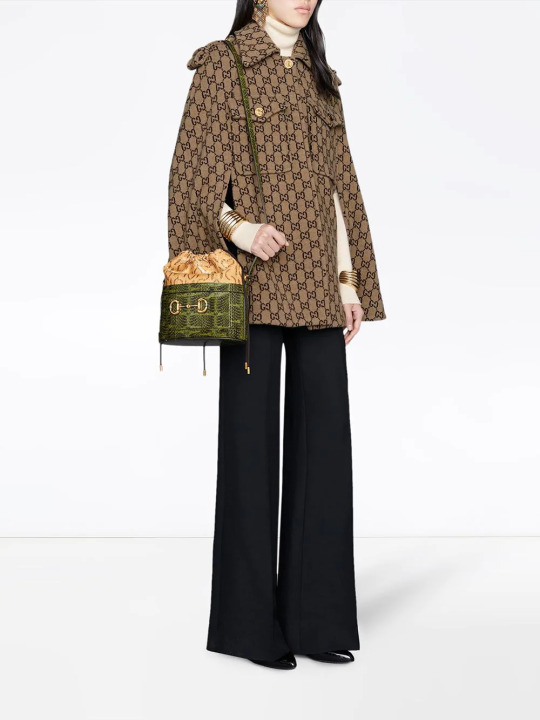
(Image source) [ID: a person wearing a brown monogrammed hip-length cape with front pockets and arm slits at the sides.]
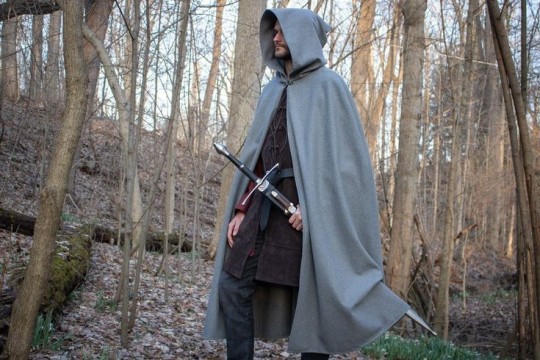
(Image source) [ID: a person wearing a long gray hooded cape, standing in a forest and holding a sword.]
Materials:
Before deciding what fabrics to make your cloak or cape out of, ask yourself what you're trying to achieve first.
Warmth, drape, fabric price, comfort, aesthetic, wearing context,... are some examples of things that can influence your decision.
Some examples:
A cosplay cloak has to look good but doesn't necessarily have to be warm. Choose a fabric that's suitable for your character's outfit, but also keep the circumstances in which you plan to wear your outfit in mind. For example, a warm cloak might pose issues if you do a lot of indoor photo shoots, but convention halls can be pretty chilly.
A fashion cloak intended for winter really does need to be warm! Wool, tweed, and velvet are good options.
A cloak intended for historical re-enactment preferably uses period-accurate materials and therefore won't be lined with fabrics like polyester and such. Which fabric to use depends on the period and region you're working in.
Tutorials and patterns:
Here's a few tutorials/patterns to get you started:
Fitted cloak: winterberry cape (Mood)
How to draft your own hooded cape (The Spruce Crafts)
Pleated half circle cape (Gilian Conahan)
Half circle capelet (Buzzfeed)
Long hooded cloak (Fleece Fun)
Full circle capelet (Project Run and Play)
Four ways to make a cape (WikiHow)
Eight types of capes (Sew Guide)
Half circle fashion cape (Indoor Shannon)
21 free cape sewing patterns (Love Sewing)
Hooded cloak with lining (Online Fabric Store)
Conclusion:
Capes and cloaks make for fun sewing projects. They're pretty easy to make: if you know how to draw circles, you know how to draft a cape pattern.
Capes are a versatile garment, and can range from a great last-minute Halloween costume to an every-day winter cloak. Play around with materials, lengths, shapes, design elements, decoration,... to achieve different effects.
And most of all: have fun with it!
28K notes
·
View notes
Text
hot glue gun that looks like a pearl-handle revolver a femme fatal would keep in her purse
3K notes
·
View notes
Text
ok are u all ready
cut 6 perfect squares out of fabric(s) of ur choice, mine are 3x3 inches but urs can be bigger or smaller. make them all different colors if u want! go hogwild w this

67K notes
·
View notes
Text
Barbie and the 12 Dancing Princesses Genevieve Cross Stitch Pattern

This pattern is 89x53, that's about 6.5x4" on 14 count. I'm actually working on this one right now and I'm planning to double up my thread and stitch backstitch ribbons on the lower legs. I forgot to add that to the pattern.
Download PDF Here
#barbie and the 12 dancing princesses#12 dancing princesses#barbie 12 dancing princesses#princess genevieve#barbie movie#barbie movies#cross stitch pattern#cross stitch#embroidery pattern#barbie
55 notes
·
View notes
Photo

(via How to sew a drawstring bag in minutes - Swoodson Says)
8 notes
·
View notes
Text
Embroidery 101

Introduction:
Embroidery is a craft that uses thread to decorate fabric (and other materials). It's a great way to spruce up a garment, customise objects, and to hide mends you've made!
Embroidery is usually done with embroidery floss, but depending on the base material you're working on, you could also use yarn, ribbons, or plain old sewing thread. Don't be afraid to experiment!
Embroidery is easier to do on taut fabric than limp fabric. That's why most people use embroidery hoops. While not strictly necessary, a hoop will make your life so much easier.
Using the right needle will help, too. Use a crewel needle if you're working with embroidery floss, a chenille needle if you're working with ribbon or yarn, or a tapestry needle if you're doing cross-stitch embroidery on open-weave fabrics.
While there are many types of embroidery from all over the world, this post will focus on some basic stitches you can use in your own work.
Basic embroidery stitches:
For a more thorough overview of embroidery stitches, check out these embroidery tutorials by Mary Corbet's Needle 'n Thread.
The following images show some of the most basic stitches:
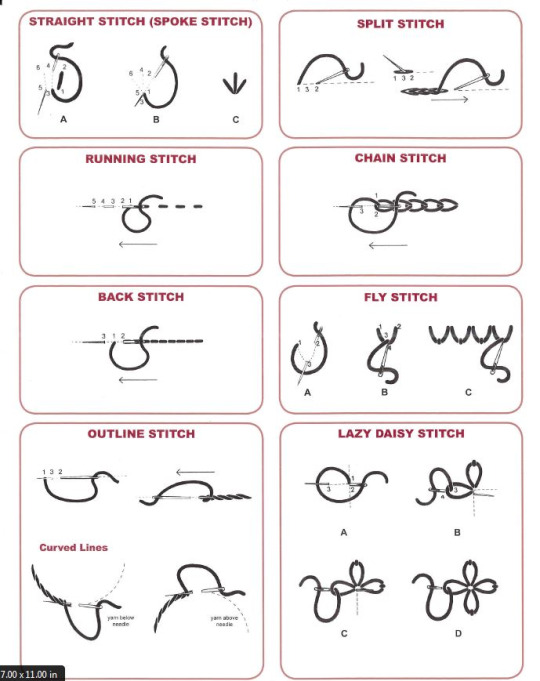
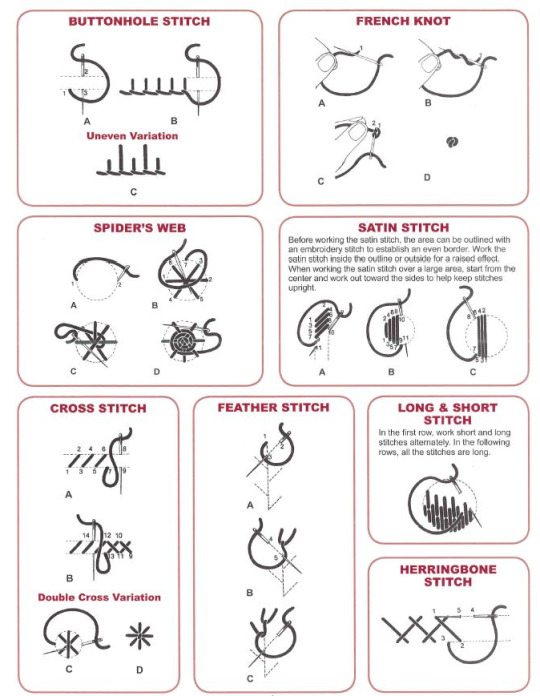
(Image source)
The 16 stitches in the images above can be combined into any shape or form you want. You might recognise some from my hand sewing post: embroidery is a type of hand sewing, after all.
You don't need to know all of these to be able to make beautiful things. Even just one of these is a great start for a project.
This sampler by Sew Nancy shows how these basic stitches can be used to outline shapes or form flowers, for example.

(Image source)
Fiorelila used a combination of the stem stitch, satin stitch, lazy daisy, and french knots to spruce up this sweater:
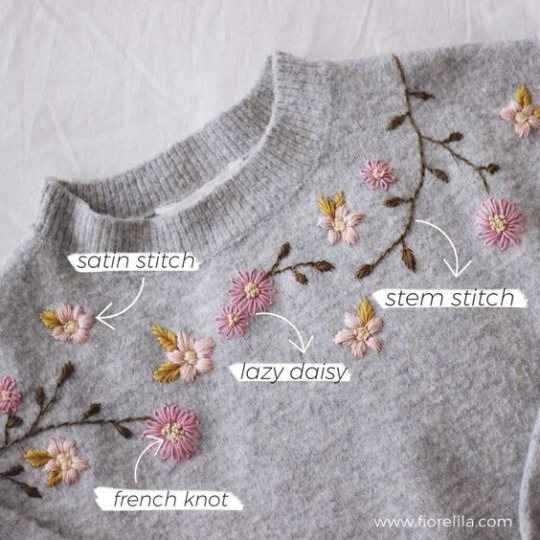
(Image source)
And this person used lazy daisies to add some flair to their jeans:
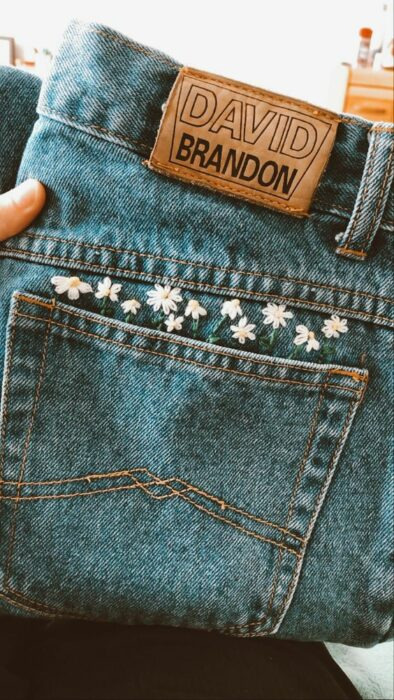
(Image source)
Embroidery for visible mending:
Embroidery is a useful tool to hide mends you've made, or to even accentuate them if that's your style. This is called visible mending. While this is a topic that deserves a post on its own, here are some quick examples:
Like this fix by Redditor Takemythyme who embroidered a rose over a hole in a knit fabric:

(Image source)
Or like how this person has spruced up their jeans repairs with embroidery:

(Image source)
In this example, The Woolery Guy chose to use flower embroidery to make a hole in a knit fabric look like it was there by design:
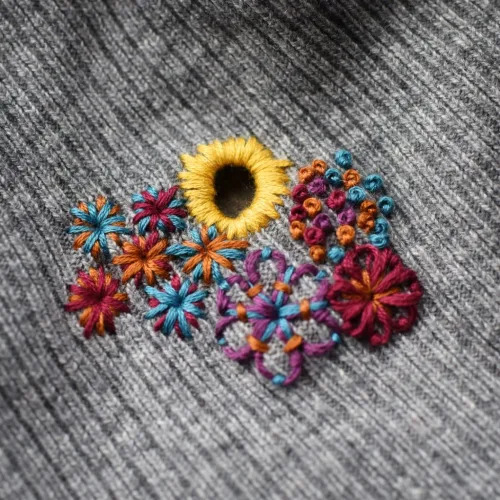
(Image source)
For more examples, check out Pinterest or VisibleMending.com.
Conclusion:
Embroidery is a useful skill to give new life to your wardrobe. You can use it to give some flair to items you've grown bored off, or even to mend your clothes.
Once you've got a few basic stitches under your belt, the possibilities are endless. Be creative and have fun with it!
Good luck and feel free to show me your work!
15K notes
·
View notes
Video
Button embroidery crafts
50K notes
·
View notes

